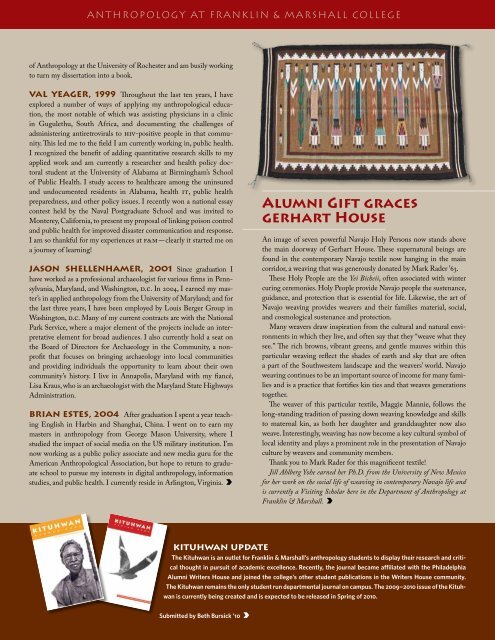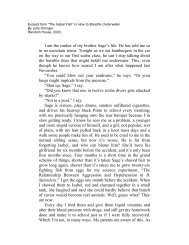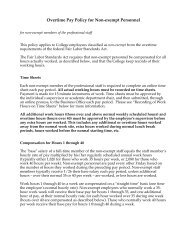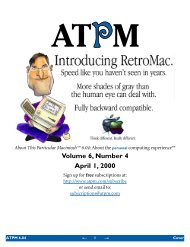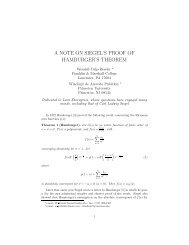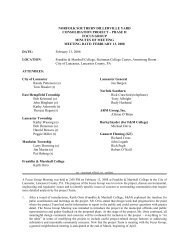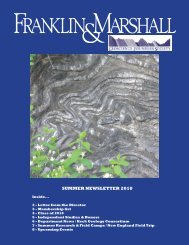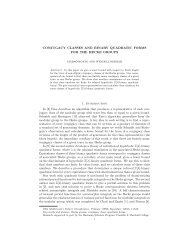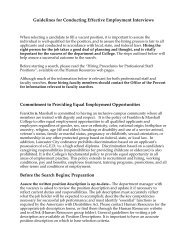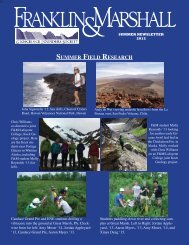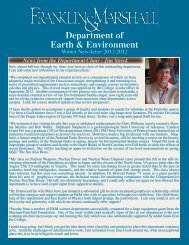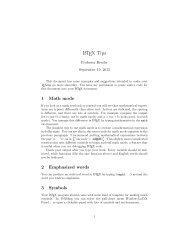From the chair - eDisk - Franklin & Marshall College
From the chair - eDisk - Franklin & Marshall College
From the chair - eDisk - Franklin & Marshall College
- No tags were found...
You also want an ePaper? Increase the reach of your titles
YUMPU automatically turns print PDFs into web optimized ePapers that Google loves.
Anthropology at <strong>Franklin</strong> & <strong>Marshall</strong> <strong>College</strong>of Anthropology at <strong>the</strong> University of Rochester and am busily workingto turn my dissertation into a book.Val Yeager, 1999 Throughout <strong>the</strong> last ten years, I haveexplored a number of ways of applying my anthropological education,<strong>the</strong> most notable of which was assisting physicians in a clinicin Gugulethu, South Africa, and documenting <strong>the</strong> challenges ofadministering antiretrovirals to HIV-positive people in that community.This led me to <strong>the</strong> field I am currently working in, public health.I recognized <strong>the</strong> benefit of adding quantitative research skills to myapplied work and am currently a researcher and health policy doctoralstudent at <strong>the</strong> University of Alabama at Birmingham’s Schoolof Public Health. I study access to healthcare among <strong>the</strong> uninsuredand undocumented residents in Alabama, health IT, public healthpreparedness, and o<strong>the</strong>r policy issues. I recently won a national essaycontest held by <strong>the</strong> Naval Postgraduate School and was invited toMonterey, California, to present my proposal of linking poison controland public health for improved disaster communication and response.I am so thankful for my experiences at F&M — clearly it started me ona journey of learning!Jason Shellenhamer, 2001 Since graduation Ihave worked as a professional archaeologist for various firms in Pennsylvania,Maryland, and Washington, D.C. In 2004, I earned my master’sin applied anthropology from <strong>the</strong> University of Maryland; and for<strong>the</strong> last three years, I have been employed by Louis Berger Group inWashington, D.C. Many of my current contracts are with <strong>the</strong> NationalPark Service, where a major element of <strong>the</strong> projects include an interpretativeelement for broad audiences. I also currently hold a seat on<strong>the</strong> Board of Directors for Archaeology in <strong>the</strong> Community, a nonprofitthat focuses on bringing archaeology into local communitiesand providing individuals <strong>the</strong> opportunity to learn about <strong>the</strong>ir owncommunity’s history. I live in Annapolis, Maryland with my fiancé,Lisa Kraus, who is an archaeologist with <strong>the</strong> Maryland State HighwaysAdministration.Brian Estes, 2004 After graduation I spent a year teachingEnglish in Harbin and Shanghai, China. I went on to earn mymasters in anthropology from George Mason University, where Istudied <strong>the</strong> impact of social media on <strong>the</strong> US military institution. I’mnow working as a public policy associate and new media guru for <strong>the</strong>American Anthropological Association, but hope to return to graduateschool to pursue my interests in digital anthropology, informationstudies, and public health. I currently reside in Arlington, Virginia.Alumni Gift gracesgerhart HouseAn image of seven powerful Navajo Holy Persons now stands above<strong>the</strong> main doorway of Gerhart House. These supernatural beings arefound in <strong>the</strong> contemporary Navajo textile now hanging in <strong>the</strong> maincorridor, a weaving that was generously donated by Mark Rader ’63.These Holy People are <strong>the</strong> Yei Bicheii, often associated with wintercuring ceremonies. Holy People provide Navajo people <strong>the</strong> sustenance,guidance, and protection that is essential for life. Likewise, <strong>the</strong> art ofNavajo weaving provides weavers and <strong>the</strong>ir families material, social,and cosmological sustenance and protection.Many weavers draw inspiration from <strong>the</strong> cultural and natural environmentsin which <strong>the</strong>y live, and often say that <strong>the</strong>y “weave what <strong>the</strong>ysee.” The rich browns, vibrant greens, and gentle mauves within thisparticular weaving reflect <strong>the</strong> shades of earth and sky that are oftena part of <strong>the</strong> Southwestern landscape and <strong>the</strong> weavers’ world. Navajoweaving continues to be an important source of income for many familiesand is a practice that fortifies kin ties and that weaves generationstoge<strong>the</strong>r.The weaver of this particular textile, Maggie Mannie, follows <strong>the</strong>long-standing tradition of passing down weaving knowledge and skillsto maternal kin, as both her daughter and granddaughter now alsoweave. Interestingly, weaving has now become a key cultural symbol oflocal identity and plays a prominent role in <strong>the</strong> presentation of Navajoculture by weavers and community members.Thank you to Mark Rader for this magnificent textile!Jill Ahlberg Yohe earned her Ph.D. from <strong>the</strong> University of New Mexicofor her work on <strong>the</strong> social life of weaving in contemporary Navajo life andis currently a Visiting Scholar here in <strong>the</strong> Department of Anthropology at<strong>Franklin</strong> & <strong>Marshall</strong>.Kituhwan UpdateThe Kituhwan is an outlet for <strong>Franklin</strong> & <strong>Marshall</strong>’s anthropology students to display <strong>the</strong>ir research and criticalthought in pursuit of academic excellence. Recently, <strong>the</strong> journal became affiliated with <strong>the</strong> PhiladelphiaAlumni Writers House and joined <strong>the</strong> college’s o<strong>the</strong>r student publications in <strong>the</strong> Writers House community.The Kituhwan remains <strong>the</strong> only student run departmental journal on campus. The 2009–2010 issue of <strong>the</strong> Kituhwanis currently being created and is expected to be released in Spring of 2010.Submitted by Beth Bursick ’10


